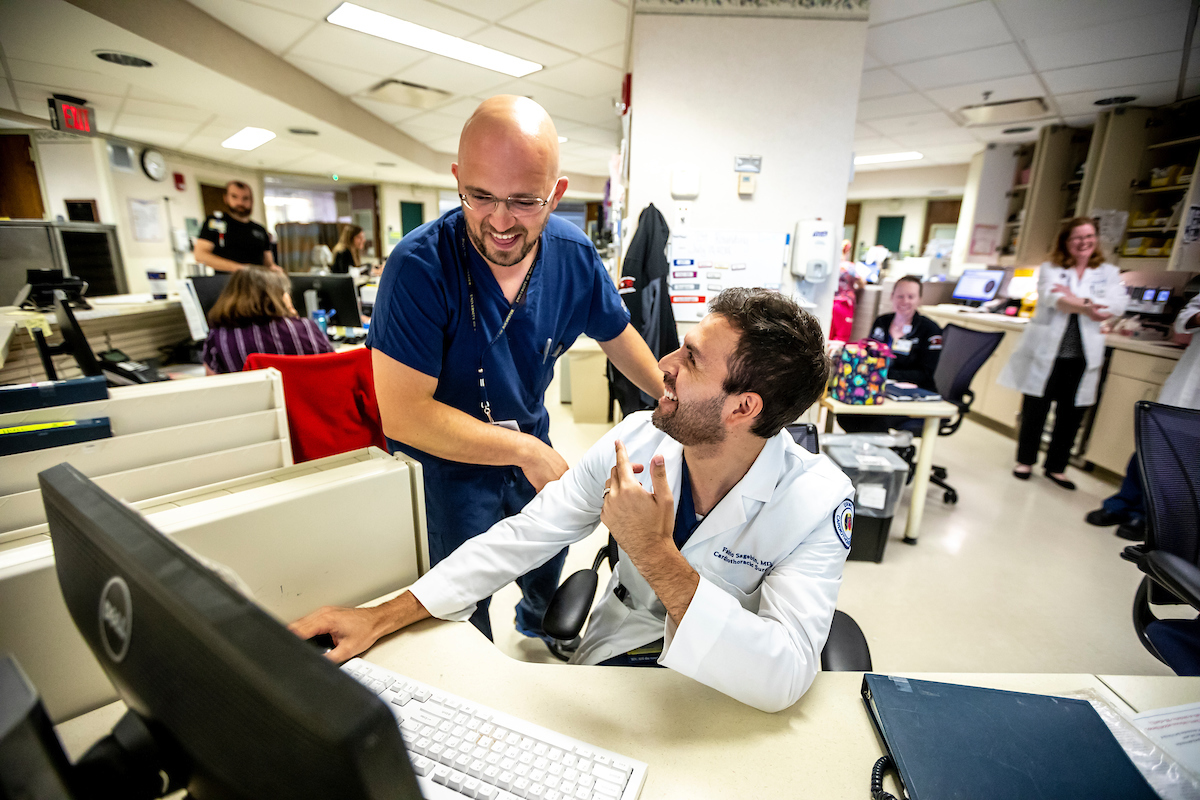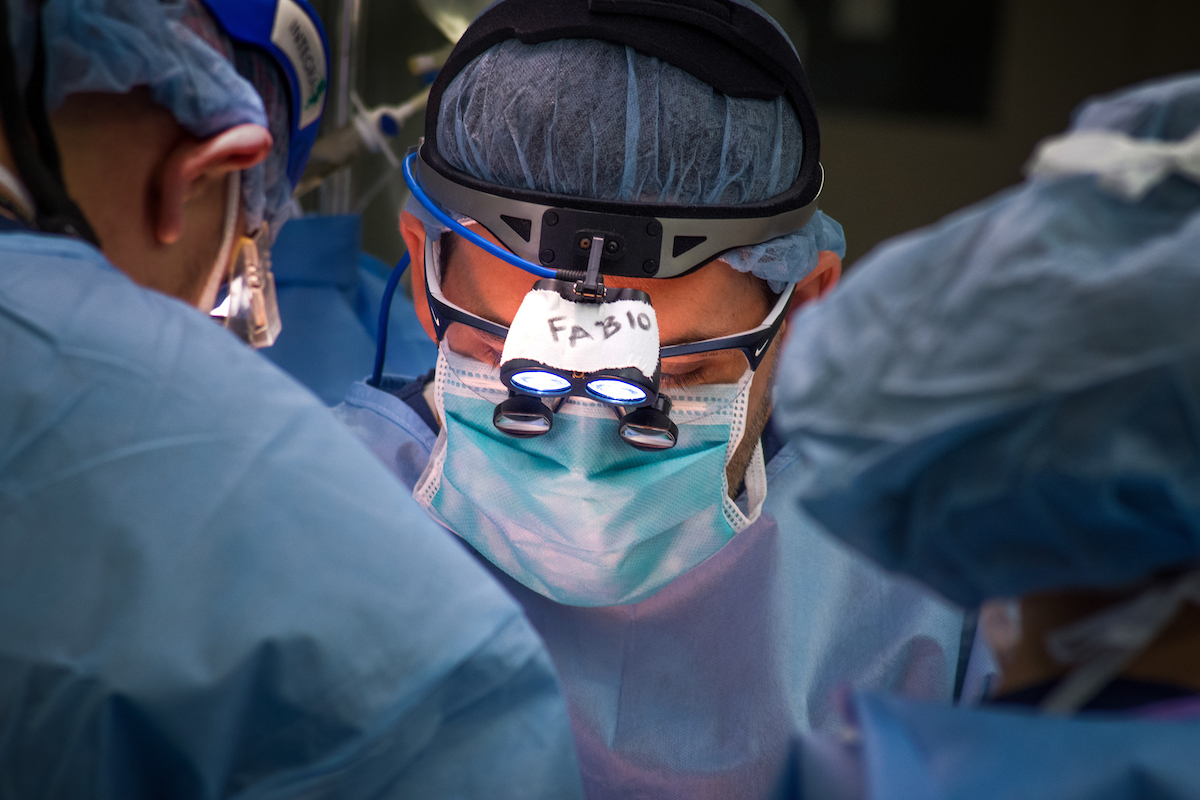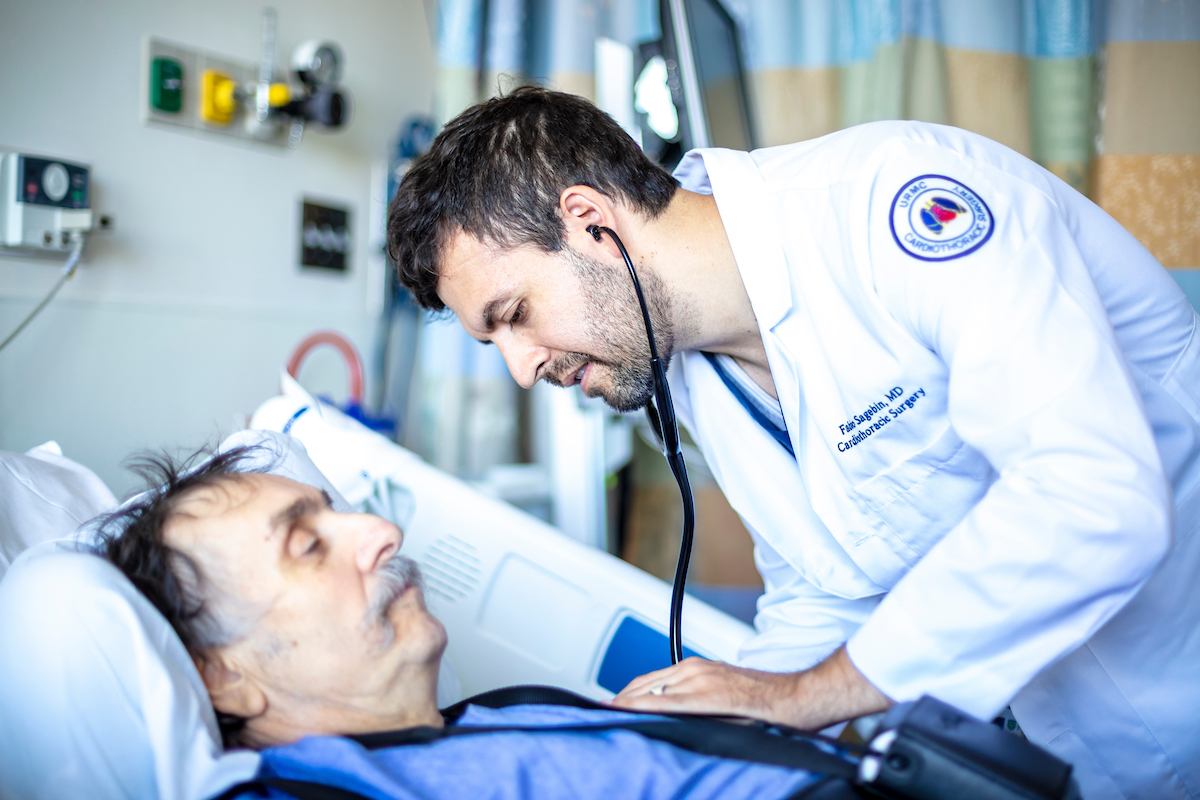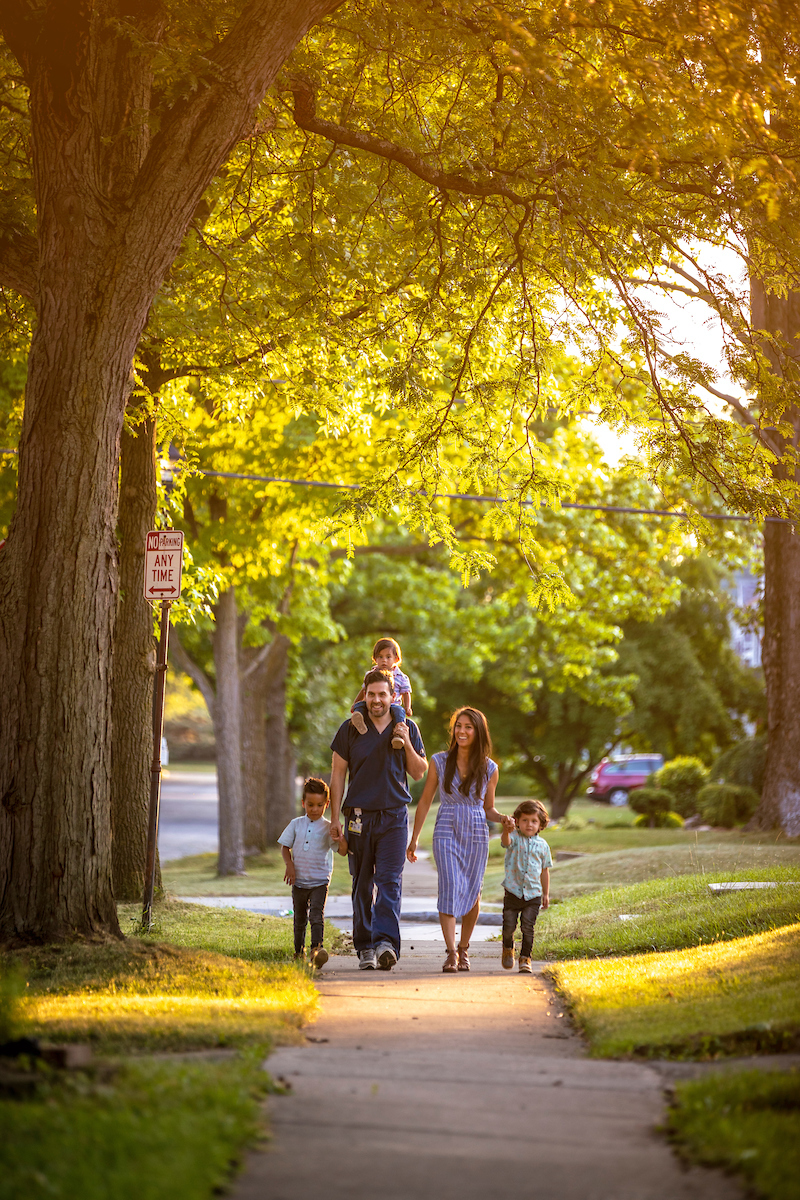
An unexpected class helps UVU graduate Fabio Sagebin find his niche in the medical world
By Jay Wamsley | Photography by Jay Drowns
A dozen years ago, soon-to-be UVU student Fabio Sagebin was doing research — on whether or not higher education was for him and, if so, where he should enroll. A dozen years from now, Dr. Sagebin will again likely be doing research — this time on better ways to repair hearts.
Currently a member of the University of Rochester Medical Center’s cardiothoracic surgery integrated residency program, Sagebin says a decade ago, he was “fully intending to finish high school, go on a mission, and come home and work construction with my dad.” His family — who had emigrated when he was 3 years old to Utah from a small city in southern Brazil, near the Uruguayan border — had begun a successful business, building steel-frame homes. His mission for The Church of Jesus Christ of Latter-day Saints had taken him to New York City, specifically Brooklyn and Queens.
A visit with his mission president “changed the trajectory for me,” Sagebin remembers. “I worked closely with my mission president, and during that mentorship he planted the seed that I really needed a formal education.

“Unfortunately, I had not really prepared for that at that point. My parents were wonderful people, hard-working people, but we didn’t have the social infrastructure necessary for college prep. It was not something that was inculcated in my family culture. I didn’t take the SAT or the ACT, and I really hadn’t prepared for college. So, when I came home, I just looked for an open-enrollment college.”
After a semester of working in Salt Lake City and studying part-time at Salt Lake Community College, Sagebin was engaged to be married and living in Utah County, staring again at the prospect of beginning a trek into higher education.
“I was now more serious about my education,” he says. “I decided to become a full-time student, and to help pay for school, I managed a group home for kids with disabilities. This gave me the flexibility and latitude to tailor my education around work and still take full-time credits. UVU was open enrollment so it was a no-brainer; I started the journey there.”
The first step was to meet with a counselor and start a core of university classes, Sagebin says, so he began with an introduction to biology course and other standard introductory classes. He says he registered for Dr. Wayne Whaley’s biology class, thinking it was an intro-level class. “Back then, there was intro to biology and a much different course, biology for pre-med, which was the one that I ended up matriculating in,” he says. “And I just remember it being really hard, and I was surrounded by kids who were pre-medical and pre-dental, and I had no idea that was what was happening.”
After confirming with several fellow students over lunch that they were, indeed, pre-medical students, the light toward the future came on for Sagebin. He says though it was a very hard class for him, he worked hard and was one of only a few students who received an A grade. An adviser in the biology department showed Sagebin several paths to take if he wanted to be a physician.

“I had no aspirations to do anything medical until then,” he says. “But after that happened, it was like the first time it occurred to me that if I tried really hard I could be a good student. I had no professional aspirations at all — I was really expecting just to take over my dad’s business. So, at that point, when the whole coursework was laid out for me, it was the first time I had considered doing anything medical."
As semesters passed, Sagebin and his wife, Christa, began to look at possible medical schools, including the University of Utah. Sagebin remembers that a graph on a webpage at the U of U showed averages in several categories for students in their program, including the average GPA, average MCAT scores, average courses taken, average hours in clinic, service hours, and so on. “I took that document and said, ‘Well, if I can double these averages, exceed the average expectations…that would be our goal,’” Sagebin says. “Our theory was that if I did that in every one of those metrics, I can probably get into a good medical school.”
Sagebin was one of three students offered “early acceptance” by the University of Utah, but he instead chose to go back to New York City for his continuing education. With his mission background there, Sagebin said a return to New York to attend NYU became “an exciting prospect for us.”
During his time at NYU, Sagebin participated in clinical and basic science research, focusing his efforts on bone-tissue engineering. He was also affected by his experiences surrounding Hurricane Sandy. He was involved in the evacuation of the NYU Medical Center — which was right in the middle of a massive power outage in lower Manhattan — carrying patients down flights of stairs to waiting ambulances, including a patient who had recently received an artificial heart. This helped galvanize his decision to pursue a career in surgery.
“It was one of those formative experiences that steered me toward acute, serious, kind of life-and-death surgery, and I couldn’t find anything more elegant and life-changing than cardiac surgery,” Sagebin says. “At the time, they were developing and offering these new integrated residencies — where before it used to take about 10 years, these new residencies were offering the same experiences in six years. There were only a few of them nationally and luckily through a lot of hard work and persistence, I was able to get one of them. That’s how I ended up at the University of Rochester as part of one of these integrated surgical residency programs.”

Sagebin, now 35, has been at the University of Rochester for five years, with one year left, and then plans to move on to a new career, for which he is actively interviewing. At URMC, in addition to clinical training in the operating room, he is involved with a number of research projects, including less-invasive approaches to heart surgery, and creating improved strategies for managing patients who need artificial hearts or who are suffering from advanced heart failure. He is also heavily involved in surgical education research, which focuses on surgical simulation and the training of surgical residents by developing training tools to help teach residents the craft of cardiac surgery.
Sagebin also works with a team at the University of Rochester biomedical engineering department to develop surgical devices for minimally invasive cardiac surgery — “the university actually got one of our devices patented,” he says — and is continuing to hone in on that topic as his sub-specialty.
The future?
“I see myself being part of a busy clinical program doing high-volume cardiac surgery,” Sagebin says. “The jobs I’m looking at now have a need for minimally invasive heart surgery, which is a newer branch of cardiothoracic surgery, where you are able to accomplish the same thing using minimally invasive approaches. Instead of opening the chest in the front, you’re using smaller incisions on the side, using cameras and different tools to accomplish the same thing…so my goal would be to start a minimally invasive cardiac surgery program somewhere in the country, and grow it and make it successful, and maybe eventually transition back into academics where I’d be involved in teaching residents and research.”
If all that doesn’t sound like enough to keep the couple — who have three young sons, Asher, Luca and Kai — busy, Sagebin and Christa also chair The Guimaras Foundation, a nonprofit that provides academic and scholastic aid to underprivileged schools in the Philippines. Begun by Marley and Bruce Sutton, an aunt and uncle to Christa, the foundation works with textbook suppliers in North America and donates thousands of textbooks to schools on the island of Guimaras.
Sagebin and his wife developed relationships with textbook publishers who were throwing away thousands of textbooks every couple of years that were considered outdated. “We were sending huge quantities of textbooks to this island in the Philippines and they were then distributing to elementary, middle school, and high school students,” Sagebin says. “It’s something that we are very proud of. We started doing it while at UVU and it’s something we are passionate about.”

Sagebin notes that incoming UVU president Astrid S. Tuminez has been instrumental in taking the foundation to the next level and led the effort in getting the foundation accredited as a nonprofit organization, to help with the benefits and legalities of donations. President Tuminez is a sister to Sagebin’s mother-in-law, Julie Ludlow.
Additionally, Sagebin notes that he and Tuminez also have shared thoughts about his history at UVU and the school’s strong dual-mission role in education.
“I know (President Tuminez) well and have spent time with her and her family. I love her family,” Sagebin says. “We both believe UVU is a very unique place. It is filling very different needs. It is remarkable to me that it is a place where you might have a single mom trying to rebuild her life, you have a high school student learning a trade, and you have a fresh high school grad who is pursuing a career in law or medicine. It is really unique to have an institution filled with people with such varying and wide goals.”
Sagebin says he also believes it is unique to have an institution that is filled with administrators and faculty so committed to the personal development of individual students.
“There were times I considered transferring, but every time I did I felt like the people at UVU were invested in my success,” he says. “I remember walking into Dr. Whaley’s office the day I got the early acceptance letter from the University of Utah and he walked over to me and gave me a hug. It was that important. He was invested in my success. It meant a lot to me. This was an inspiring thing, that he took the success of his students personally. And I think you get that at an institution that is catering to many different needs. The administration needs to continue being that invested in identifying those students who have those ambitions, and creating an infrastructure that will allow them to succeed, and I think they will continue having these success stories.”
Sagebin said he envisions a time when UVU will have a “robust pre-medical society” with clinical experiences and resources coordinated to help a growing fraternity of pre-medical students, many of whom are being accepted into prestigious universities. “I think that would be just incredible,” he says.